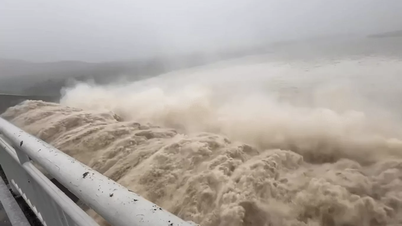
Janjucetus dullardi, a new species discovered in the Australian state of Victoria, is “a small whale with large eyes and a mouth full of sharp, razor-sharp teeth for tearing prey” - Illustration: Museums Victoria
According to the Guardian newspaper, scientists at the Victoria Museum Research Institute have just discovered traces of an ancient whale species called Janjucetus dullardi from a 25 million year old fossil found on the coast of Victoria state (Australia).
It is the fourth known species belonging to the mammalodontids, an early branch of the baleen whale family.
This species is described as small and cute but has sharp teeth like knives, eyes almost the size of tennis balls and is considered "absolutely not harmless".
Dr Erich Fitzgerald, head of vertebrate paleontology at the institute, said it was an extremely unusual animal, about the size of a dolphin but with a strong skull, a short snout, and deep teeth for biting and tearing prey.
They bear little resemblance to their modern relatives in the baleen whale group, which includes the giant blue whale.
“Imagine a shark version of a baleen whale – small but extremely dangerous,” says co-author Ruairidh Duncan.
The fossil found included a partial skull, ear bones and eight teeth - enough to identify it as a new species.
Janjucetus dullardi lived during the Oligocene period (30 to 23 million years ago), when the Earth was warmer than it is now and sea levels were rising. As an adult, the species was about 3m long, but the fossil specimen is thought to be a juvenile, only 2-2.2m long.
Evidence from plankton fossils in the Jan Juc bedrock suggests that southern Australian waters were warmer than they are today, similar to the subtropical waters off Coffs Harbour.
This was a rich habitat for life, with small whales, giant penguins, sharks one and a half to twice as long as today's great white sharks, and many other primitive whale and dolphin species.
Scientists say this was a turning point in the history of marine life, a period that marked an explosion in the diversity of whales and dolphins.
Professor John Long (Flinders University) said this discovery helps to better understand the evolutionary steps from carnivorous whales to filter-feeding animals, and also emphasizes the important role of field surveys.
The fossil was found in 2019 by headteacher Ross Dullard while walking on Jan Juc beach. He donated the specimen to the museum and was honored when the new species was named after him.
Dr Fitzgerald stressed the important role of the public in Australian palaeontology, saying this was proof that fossils “that can change the scientific world ” could be found locally, in your own backyard if you looked and searched.
Source: https://tuoitre.vn/phat-hien-chung-cu-cua-loai-ca-voi-co-dai-ve-ngoai-de-thuong-nhung-nguy-hiem-o-uc-20250813113337717.htm



![[Photo] The Standing Committee of the Organizing Subcommittee serving the 14th National Party Congress meets on information and propaganda work for the Congress.](https://vphoto.vietnam.vn/thumb/1200x675/vietnam/resource/IMAGE/2025/11/19/1763531906775_tieu-ban-phuc-vu-dh-19-11-9302-614-jpg.webp)






















![[INFOGRAPHIC] Political career of former Bangladeshi Prime Minister sentenced to death](https://vphoto.vietnam.vn/thumb/402x226/vietnam/resource/IMAGE/2025/11/19/1763554115072_thumb-cuu-thu-tuong-bangladesh-1-jpg.webp)










![[Photo] Prime Minister Pham Minh Chinh and his wife meet the Vietnamese community in Algeria](https://vphoto.vietnam.vn/thumb/1200x675/vietnam/resource/IMAGE/2025/11/19/1763510299099_1763510015166-jpg.webp)
![[Photo] General Secretary To Lam receives Slovakian Deputy Prime Minister and Minister of Defense Robert Kalinak](https://vphoto.vietnam.vn/thumb/1200x675/vietnam/resource/IMAGE/2025/11/18/1763467091441_a1-bnd-8261-6981-jpg.webp)









































































Comment (0)